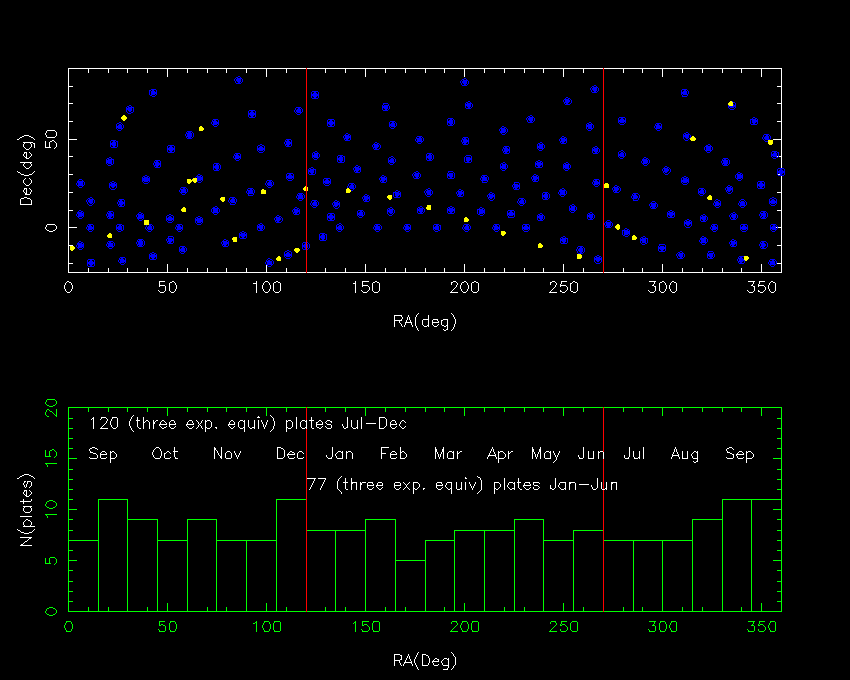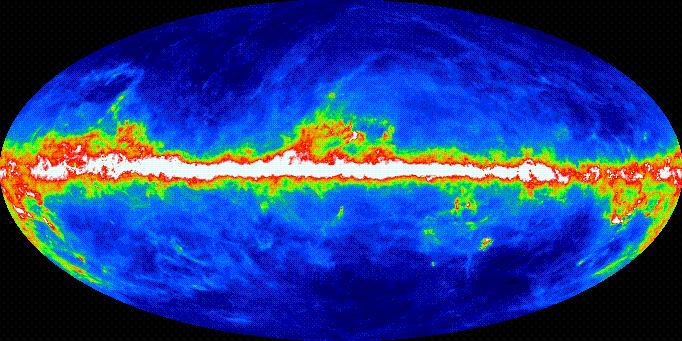
| SDSS Classic |
| SDSS.org |
| SDSS4.org |
| SDSS3.org |
| SDSS Data |
| DR17 |
| DR10 |
| DR7 |
| Science |
| Press Releases |
| Education |
| Image Gallery |
| Legacy Survey |
| SEGUE |
| Supernova Survey |
| Collaboration |
| Publications |
| Contact Us |
| Search |

|
About |
For Scientists |
Publications |
Illustrative Spectra
|
SEGUE Spectroscopy
Quick Links |
A sampling of stars from the imaging data (see Sky Coverage) is targeted for spectroscopic observations. Candidates are assigned to a series of plates, each of which targets 640 objects. Spectra are measured using a a pair of double spectrographs that cover a wavelength range of 3800-9200Å with a resolution of &lambda/&Delta&lambda ~ 1800.
The distribution of SEGUE plates in RA and dec is shown below:

Two plates are exposed in each of 200 directions on the sky (for a total of 400 plates):
- one bright plate, with an exposure time of about 45 minutes,
- and one faint plate, with an exposure time of about 1.5 hours.
Note that SEGUE obtains its spectroscopic target positions from both the Legacy SDSS Imaging Footprint and the lower latitude SEGUE Imaging.
The SEGUE Stellar Stellar Parameter Pipeline (SSPP) has been developed to extract atmospheric parameters from the spectra. Radial velocities (with errors ~ 5 - 25 km/s) and fundamental stellar atmospheric parameters (Teff, surface gravity, and metallicity) are determined for stars at distances from 2 to 150 kpc from the Sun. Rare objects, such as cool white dwarfs (with distances < 100 pc) are also targeted. A detailed description of the SSPP can be found in Lee et al., 2007.

Galactic Dust: All Sky view of the IRAS 100 um imaging data, representing a
MONTAGE-generated combination of the individual images created by
Schlegel, Finkbeiner & Davis (1998). (Blue is low intensity, red/white is high intensity).
NASA/IRSA
Interstellar Medium (ISM)
Observations of stars at relatively low latitude are key to revealing the structure, kinematics and composition of the Galactic disks. However, the interstellar medium – clouds of gas and dust that permeate the disks – modifies the starlight that reaches telescopes on Earth. The ISM can block or change the observed color of light from stars, and the amount of extinction and reddening depends on how much dust lies between a particular star and the observer.
Modern dust maps are two-dimensional on the sky; a better understanding of the three-dimensional distribution of dust in the Galaxy is essential in order to accurately correct for the effects of the ISM. SEGUE will be instrumental in helping to create such a three-dimensional map of the ISM.
SEGUE will combine its optical catalogs with the 2MASS point source catalog in order to better determine the amount of reddening for the brighter stars observed by SEGUE and help resolve ambiguities in stellar identifications.
Determination of Extinction and Reddening
SDSS utilizes the SFD dust map, derived from maps of the infrared emission from dust across the sky, to predict the extinction in each of the five SDSS ugriz colors. The resulting extinction maps are used to correct the observed magnitudes of quasars and galaxies before spectroscopic target selection.
SEGUE scans provide an important check of the SFD map, which is crucial for
- correcting observations of extragalactic objects for extinction
- measuring an important CMB "foreground"
- understanding and improving the assumed model of the dust mass, composition and distribution.
Spatial Mapping of the Local ISM
SEGUE will use M dwarf stars to probe the three-dimensional structure of the local dust at distances ranging from 100 to 1000 pc (where the bulk of the extinction is expected to occur). M dwarfs are numerous, have a well-defined color-absolute magnitude relation, and their g - r colors lie in a narrow locus about g - r = 1.4. The spatial variation of M dwarf g -r colors observed by SEGUE will be transformed in a map of cloud locations using techniques such as maximum entropy reconstruction.